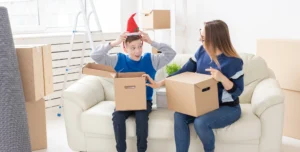
- Home
- -
- How to Make a New City Feel Like Home
How to Make a New City Feel Like Home
Moving to a new city feels like arriving at a party where you don’t know anyone; there’s excitement all around, but it takes time to find your people and feel at ease.
Everything is unfamiliar—the streets, routines, even small details like your favorite coffee spot. It’s natural to feel a bit out of place at first.
There’s excitement in exploring, but also quiet discomfort from unfamiliar routines, empty social circles, and the search for that ‘at home’ feeling.
And it can feel challenging; without the right mindset, homesickness and loneliness can settle in.
In fact, studies show that people who move frequently are more likely to feel lonely and struggle to form lasting social connections in adulthood.
That’s why making a new city feel like home is more than unpacking boxes. It’s about building routines, finding your people, and turning unfamiliar places into everyday favorites.
So, before the excitement turns to uncertainty, let’s explore simple steps to help you adjust, connect, and make this new city feel like yours.
Step 1: Start with the Right Mindset
When you’re learning how to make a new city feel like home, the most important place to start isn’t with a checklist; it’s with your mindset.
The way you think about this move will shape your entire experience.
Embrace the Change: Adjusting to a new city means letting go of the familiar and embracing new experiences. Whether you moved for work, family, or a fresh start, focusing on what’s ahead helps you stay open, even when it feels uncomfortable.
Be Patient with the Process: Adjusting to a new environment takes time. Some days will feel exciting, while others will feel lonely, and both are part of the journey. Be patient. Every connection you make and each new place you discover bring you closer to feeling at home.
Step 2: Make Your Space Feel Like Home
Once your mindset is in the right place, the next step to making a new city feel like home starts right inside your living space.
Your environment plays a significant role in adjusting to a new city, so creating a space that feels familiar can make the transition easier.
Personalize Your Living Space: Unpack your favorite things first—the photos, blankets, decorations, or anything that reflects your personality. Even if your new place isn’t fully set up yet, adding familiar touches helps bring comfort from the very start.
Create Cozy Daily Rituals: Feeling at home in a new city often comes down to the small routines. Brew your morning coffee the way you always do or unwind with your favorite book or show.
Step 3: Get to Know Your New Neighborhood
After creating a comfortable space at home, the next step is to look beyond your front door and explore your surroundings.
Every area has its unique personality, with local cafes, parks, shops, and small, hidden spots that make life more enjoyable.
Explore Local Spots and Landmarks: Start by walking through your neighborhood. Visit nearby parks, restaurants, and stores. Even casual strolls help the streets become recognizable and take away that unfamiliar feeling.
Find Your Go-To Places: Feeling at home in a new city often comes down to small routines. Whether it’s your morning coffee spot, the grocery store you frequent, or a park bench with a view, these familiar places bring comfort to your daily life.
Step 4: Build New Connections
Exploring your new neighborhood helps you feel grounded, but finding your people is what truly makes a city feel like home.
It’s easy to stick to familiar routines and avoid meeting new people, especially when you’re still settling in. But creating relationships, even small ones, helps ease feelings of loneliness and makes the transition smoother.
Join Local Groups and Clubs: Look for local groups that align with your hobbies or interests. Whether it’s a fitness class, a volunteer opportunity, or a community meetup, these spaces are great for meeting new people naturally.
Attend Events and Meet New People: Many cities have neighborhood events, festivals, or workshops. Attending local gatherings is a simple, low-pressure way to start conversations and meet others who are also looking to build connections in a new city.
Use Social Apps to Make Friends: Technology can help break the ice and facilitate connections. Apps and platforms designed for meeting people, whether for friendship, networking, or shared interests, are useful tools when making friends in a new city.
Step 5: Establish Comfortable Daily Routines
Meeting new people helps build connections, but it’s the daily routines that bring stability and comfort when you’re settling into a new city after moving.
Even small habits can make a big difference when everything else feels unfamiliar.
Stick to a Familiar Schedule: Keep elements of your old routine. Morning coffee, workout sessions, or evening walks—familiar habits give your days structure and make adjusting to a new city feel less overwhelming.
Include Activities That Feel Like “You”: Find ways to include activities that reflect your personality. Whether it’s finding a local coffee shop, joining a gym, or exploring parks, these familiar comforts help you feel at home in a new city.
Step 6: Explore and Embrace the Local Culture
Once your daily routines bring a sense of stability, it becomes easier to lean into new experiences and explore everything your city has to offer.
Feeling at home in a new city isn’t just about creating your own space or schedule; it’s also about embracing what makes your new community unique.
Try Local Food and Experiences: Exploring local restaurants, markets, and entertainment spots is a great way to get familiar with the city. Food brings people together, and trying local flavors adds comfort and enjoyment to your new surroundings.
Learn the City’s History and Traditions: Understanding your city’s story can help you feel a deeper connection to it. Whether it’s visiting landmarks, museums, or attending cultural events, learning about your new home makes the unfamiliar feel more meaningful.
Step 7: Stay Connected to Your Roots
As you explore new places and settle into your city’s culture, it’s equally important to stay grounded in what feels familiar.
Building a new life doesn’t mean letting go of where you came from. Keeping parts of your old life close can provide emotional stability and make the transition smoother.
Keep in Touch with Friends and Family: Regular calls, texts, or video chats with friends and family can make all the difference. Even short check-ins provide support and remind you that your connections extend beyond your current location.
Celebrate Small Wins in Your New City: Adjusting to a new city after moving is a journey, and every small victory counts. Whether it’s finding a favorite spot, making a new friend, or simply navigating your neighborhood confidently, celebrate those milestones.
Avoid These Common Mistakes When Moving to a New City
As you build routines, make new connections, and stay in touch with your roots, it’s normal to face challenges when settling into a new city after moving.
However, certain mistakes can make the process feel even harder than it needs to be.
|
Mistake |
How to Avoid It |
|
Isolating Yourself |
Get outside daily and engage with your surroundings; even brief conversations can be beneficial. |
|
Compared to Your Old City |
Stay curious, explore new places without constantly comparing them. |
|
Avoiding New Experiences |
Say yes to meetups, events, or local activities to build confidence. |
|
Skipping Daily Routines |
Establish simple habits, such as morning coffee or evening walks, to create structure. |
|
Expecting Instant Comfort |
Give yourself time, and building comfort and familiarity happens gradually. |
Recommended Resources
FAQs
Everyone adjusts at their own pace, but it typically takes a few months to start feeling comfortable. Building routines, exploring your neighborhood, and making connections can speed up the process.
Start by finding your go-to spots—like a coffee shop, grocery store, or local park. Creating small daily routines helps bring familiarity to your new environment.
Joining local groups, attending community events, or using social apps designed for making friends in a new city are great ways to build connections.
Yes, feeling lonely or disconnected is very common in the early stages of adjusting to a new city. The key is to stay patient, get involved in your local community, and stay connected to friends and family from home.
Focus on building routines, exploring your neighborhood, trying new experiences, and being open to meeting new people. Taking small steps consistently helps you feel at home faster.
Recent Post


Local vs. Long-Distance Moves

What Movers Won’t Move

How to Pack for a Long-Distance Move

How to Move in Summer, Monsoon and Winter

How to Move Plants Safely

How to Move During the Holidays

Top Moving Trends 2025

DIY vs. Professional Movers

